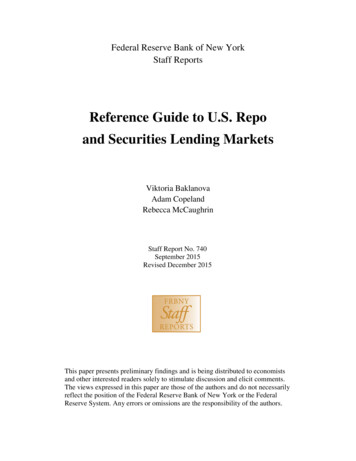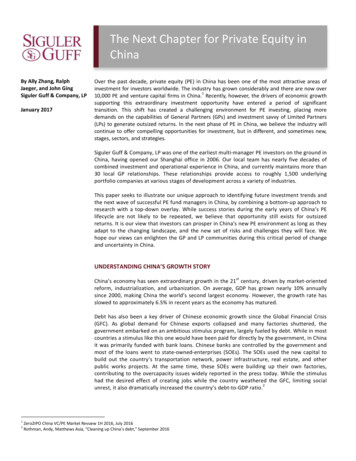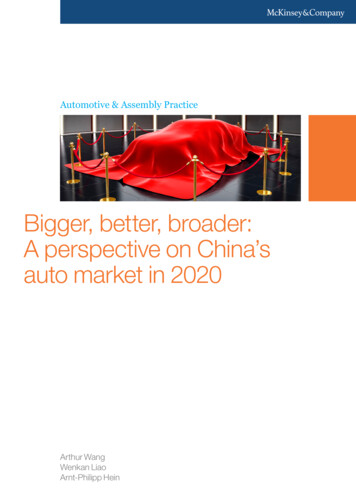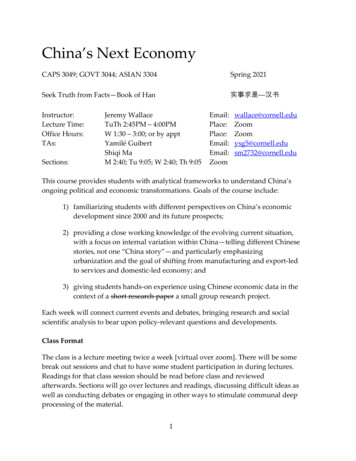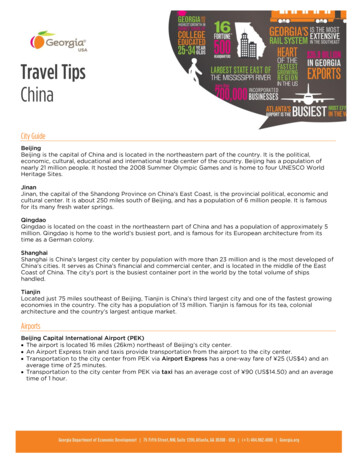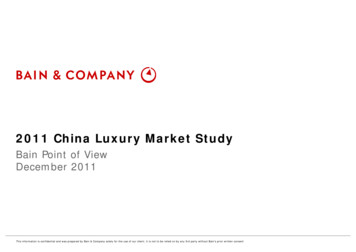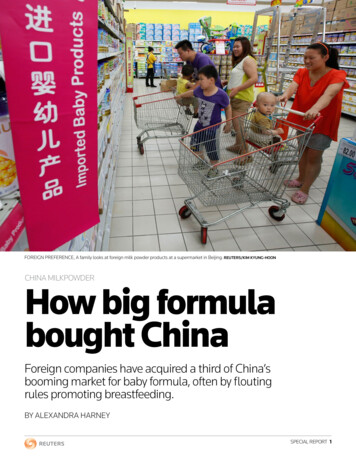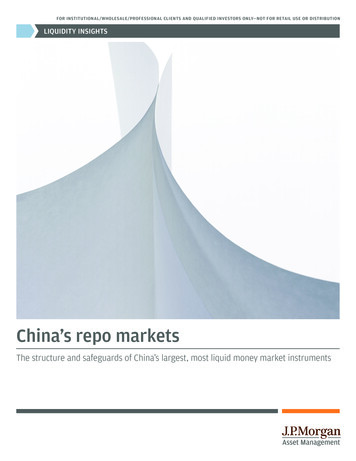
Transcription
FOR INSTITUTIONAL/WHOLESALE/PROFESSIONAL CLIENTS AND QUALIFIED INVESTORS ONLY—NOT FOR RETAIL USE OR DISTRIBUTIONLIQUIDITY INSIGHTSChina’s repo marketsThe structure and safeguards of China’s largest, most liquid money market instruments
ABOUTJ.P. MORGAN GLOBAL LIQUIDITYJ.P. Morgan Global Liquidity believes in creating long-term, strategic relationships withour clients. We bring value to these relationships through extensive liquidity managementcapabilities, which are global in reach, comprehensive in solutions and relentless in riskcontrol. J.P. Morgan Global Liquidity is one of the largest managers of institutional moneymarket funds in the world, with dedicated investment management professionals aroundthe globe. This positions us to offer best-in-class investment solutions spanning a rangeof currencies, risk levels and durations, designed to suit our clients’ specific operating,reserve and strategic cash management needs.
TA B L E O F C O N T E N T S1EXECUTIVE SUMMARY2 I N T R O D U C T I O N3W H AT I S R E P O : T E R M S A N D D E F I N I T I O N S7I N T E R B A N K R E P O : O P E R AT I O N S , Y I E L D A N D V O L U M E8I N T E R B A N K R E P O : C O L L AT E R A L A N D C O U N T E R PA R T Y R I S K9S T O C K E X C H A N G E R E P O : O P E R AT I O N S , Y I E L D A N D V O L U M E10S T O C K E X C H A N G E R E P O : C O L L AT E R A L A N D C O U N T E R PA R T Y R I S K13REPO FOR MONEY MARKET FUNDS15CONCLUSION16A P P E N D I X : R E P O R E G U L AT O R S , M A R K E T S A N D FA C I L I TAT O R S
EXECUTIVE SUMMARY4LO N G - T ER M C A P IT A L M ARK ET RETURN AS S UM PTIO NS
EXECUTIVE SUMMARYAIDAN SHEVLINREPURCHASE AGREEMENTS (REPOS) are a crucial component of globalfinancial markets, increasing market efficiency and liquidity. In Western markets,long and widespread use of repo, combined with strong legal status under bankruptcylaws and the clarity provided by a master agreement for repo transactions, offerstransparency and reassurance to investors and participants.Chinese repo markets also follow standardized policies and procedures. However,the lack of clarity regarding collateral and counterparty risk, as well as confusion abouthow repo markets operate, has created uncertainty and concern, especially amongWestern investors.ANDY CHANGThere are two types of Chinese repo: interbank and stock exchange. RMB money marketfunds (MMF) favor stock exchange repo, which provides quasi-sovereign counterpartyrisk and more timely settlement than interbank repo, albeit with greater volatility.Because it offers uniform counterparty risk, real-time monitoring and genuine marketdriven dynamics, stock exchange repo is widely recognized as the most accurate measureof funding costs, liquidity conditions and market stresses in Chinese financial markets.Repo is an important investment option for RMB money market funds. Their ability tooffer higher, market-driven interest returns helped spur the growth of MMF assets in Chinato a record CNY 2.5 trillion as of April 2015. Essential to this success has been the abilityto invest in repo.Once they understand the organization, mechanics and structure of Chinese repo markets,cash investors will be able to appreciate how repo has helped RMB money market fundsprovide relatively attractive returns with flexible liquidity.Aidan Shevlin, CFAAndy Chang, CFAManaging DirectorHead of Asia Pacific Liquidity Fund ManagementJ.P. Morgan Asset ManagementVice PresidentAsia Pacific Liquidity Fund ManagementJ.P. Morgan Asset ManagementJ.P. MORGAN ASSE T MA N A G E ME N T1
INTRODUCTIONINTEREST RATE LIBERALIZATION, a key element in China’s financial sectorreform, is now under way. As it progresses and the government’s market presence recedes,interest rates will become more market-driven. Investors will then be required to developa heightened awareness of risk as the range of investment options increases.However, Chinese interest rates have not yet fully liberalized. As a result, there is a limitedrange of suitable, market-driven investment instruments available to investors. As the largest,most liquid money market instrument in Chinese markets, repo is a major holding forRMB money market funds.Still, some RMB money market fund investors are concerned about repo market operations,collateral quality and counterparty risk. In the following pages, we explain the market’s structure,safeguards and benefits, addressing and allaying those concerns, and making clear how andwhy repo has become such a critical component of RMB money market funds.2C H IN A ’ S R EP O MA R K ETS
What is repo:terms and definitionsA repurchase agreement, or repo, is a contract for the sale of a security with a commitment by the sellerto buy the same security back from the buyer at a specified price on a designated future date.1A counterparty (the repo seller, often a broker/dealer) is borrowing money and providing collateral forthe loan while the second party (the repo buyer, often a money market fund) is lending money and acceptingsecurities as collateral for the loan. The seller gains access to funds at lower funding costs than are typicallyavailable elsewhere. The buyer obtains an attractive yield on a short-term, secured, liquid investment.Repo collateral typically comprises government bonds but can also include money market instruments,agency securities and asset- and mortgage-backed securities. The decision on which collateralto use is negotiable between the repo counterparties and will impact the interest rate offered and thehaircuts required.Repo is effectively a short-term, interest-bearing loan against a pool of collateral, but while repos resemblecollateralized loans, their treatment under bankruptcy law is more beneficial to the buyer. That is becausea buyer can sell the collateral quickly in the event of a counterparty default.2Every repo trade consists of six negotiable variablesEXHIBIT 1: KEY REPO VARIABLESRepo variablesDetailsTransaction sizeBased on the cash size of the tradeCollateralThe securities offered by the seller; the characteristics and quality of the collateralimpact the size of the haircutHaircut/marginDifference between the value of the cash and the value of the collateral (as a percentage)Maturity dateRepurchase date for the repoCounterpartiesThe buyer and seller; the creditworthiness of the seller also impacts the size of the haircutInterest rate/repo yieldPaid by the seller; affected by market rates, collateral, tenor and counterpartySource: J.P. Morgan Asset Management; as of May 31, 2015.12Source: Frank J. Fabozzi, The Global Money Markets (Wiley Finance, July 2002).According to market convention, “repo” refers to a transaction in which a dealer acts as a seller—borrowing money and providingsecurities as collateral. In reverse repo, a dealer acts as a buyer—borrowing securities and lending money.J.P. MORGAN ASSE T MA N A G E ME N T3
WHAT IS REPO: TERMS AND DEFINITIONSAcross global money markets, repos provide an efficientmechanism for financing bond positions, enabling marketmakers to take long and short positions, and providing shortterm investors with a relatively low-risk investment opportunity.A liquid repo market is a key element of a liquid bond marketand is especially important to market participants that relyon wholesale funding or face restrictions on unsecured linesof credit. The terms and definitions we have described applyto both Western and Chinese repo markets, but there aresignificant differences between the two.AN OVERVIEW OF WESTERN REPO MARKETSIn Western markets, two repo structures have evolved: bilateraland tri-party, both of which are traded in over-the-countermarkets (EXHIBIT 2). A bilateral repo involves two parties,the buyer and the seller. A tri-party repo involves a tri-partyagent (TPA) as well as the two parties. The agent takes onthe administrative functions of receiving, reporting, settlingand delivering the repo securities—simplifying the operationalcomplexities for both counterparties.Western repo market participants use the global masterrepurchase agreement (GMRA).3 It outlines the terms andconditions of the repo contract, including rules concerningmargin maintenance and procedures in the event of default.While both counterparties are exposed to credit and defaultrisk in a repo transaction, the buyer is usually in the morevulnerable position. Therefore, careful counterparty andcollateral selection is important to minimize counterpartydefault risk, collateral default risk and collateral impairment.Counterparty default risk can be reduced by using internalcredit analysis and nationally recognized statistical ratingorganization (NSRO) ratings to identify higher qualitycounterparties. Collateral default and impairment risk aremitigated by ensuring that collateral is high-quality, liquidand uncorrelated with the seller.Repo transactions are normally over-collateralized. That is,the value of the collateral exceeds the value of the cashexchanged. The excess collateral is known as a “haircut,”or margin. Haircuts are based on historical volatility, marketconvention and collateral quality.If the market value of the collateral falls below the repotransaction size (margin deficit), the seller is required to commitadditional cash or acceptable securities to cover the difference.In the event of a seller default, the repo buyer can seize andsell the collateral to compensate for the loss of principal andinterest.Repo is effectively a short-tem, interest-bearing loan against a pool of collateralEXHIBIT 2: WESTERN REPO MODELSBILATERAL REPO MODELTRI-PARTY REPO MODELSECURITIESBUYER/CASH PROVIDER(collateral receiver)TRADE DETAILSCurrencyPrincipalRepo rateCollateral & haircutTrade datesCASHBUYER/CASH PROVIDER(collateral receiver)SELLER/CASH TAKER(collateral giver)CASHTRADE DETAILSCurrencyPrincipalRepo rateCollateral & haircutTrade datesTRI-PARTYCOLLATERALACCOUNTSource: J.P. Morgan Asset Management; as of May 31, 2015.3Published by either the Securities Industry and Financial Markets Association or the International Capital Market Association.4C H IN A ’ S R EP O MA R K ETSSELLER/CASH TAKER(collateral giver)SECURITIES
WHAT IS REPO: TERMS AND DEFINITIONSAN OVERVIEW OF CHINESE REPO MARKETSAs Chinese interest rates are not yet fully liberalized, there is very little relationship between the demand and supply of liquidity onthe one hand and benchmark interest rates on the other. In contrast, interest rates for repo transactions are commonly regardedas the most accurate indicator of the true cost of liquidity. Indeed, repos represent the largest, most efficient and most liquid segmentof financial markets.There are two repo markets in China, interbank and stock exchange,4 each with different structures, characteristics and rules(EXHIBIT 3 and EXHIBIT 4).Chinese repo trades on two different platformsEXHIBIT 3: CHINESE REPO MODELSINTERBANK REPO MODELBUYER/CASH PROVIDER(collateral receiver)TRADE DETAILSPrincipalRepo rateCollateral & haircutTrade datesSTOCK EXCHANGE REPO MODELSELLER/CASH TAKER(collateral giver)BUYER/CASH PROVIDER(collateral receiver)EXCHANGE SETCollateral & haircutRepo rateRepo tenorsSELLER/CASH TAKER(collateral giver)SECURITIESCASHSECURITIESCASHCHINA CENTRALDEPOSITORY & CLEARINGTransfer agentSTOCKEXCHANGECOUNTERPARTYCHINA SECURITIES DEPOSITORY& CLEARING CORPORATIONCollateral accountSource: J.P. Morgan Asset Management; as of May 31, 2015.Repos are an important indicator of the true cost of liquidityEXHIBIT 4: KEY CHARACTERISTICS OF CHINESE REPO MARKETSCharacteristicsRepo typeParticipantsTenorsInterest rate/yieldEligible collateralCollateralregistrationTrading hoursSupervisorHaircutTrade size (CNY)EstablishedInterbankPledged, outright (buy/sell) or X-repoBank and non-bank financial institutionso/n, 7d, 14d, 21d, 1m, 3m, 4m, 6m, 9m, 12mNegotiated between counterpartiesNegotiated between counterpartiesChina Central Depository & Clearing Co., Ltd. (CCDC)Shanghai Clearing House (SCH)09:00–12:00 and 13:30–16:30People’s Bank of China (PBoC)Negotiated between counterpartiesNegotiable (min) / 500mm (average) / unlimited (max)1997Stock exchangePledged or agreementNon-bank financial institutions, corporates & retail investors1d, 2d, 3d, 4d, 7d, 14d, 28d, 91d, 182dMarket-drivenSet by exchangeChina Securities Depository &Clearing Corporation (CSDCC)09:30 –11:30 and 13:00–15:00China Securities Regulatory Commission (CSRC)Set by exchange100k (min) / 100mm (average) / unlimited (max)1991Source: J.P. Morgan Asset Management, Wind, Shanghai Stock Exchange, Fitch Ratings; as of May 30, 2015.4The Shanghai and Shenzhen stock exchange repo markets operate with exactly the same rules and regulations, albeit with different collateral pools. However,the volume of Shenzhen repo is very low; therefore, only Shanghai repo trading and volumes are covered in this document.J.P. MORGAN ASSE T MA N A G E ME N T5
WHAT IS REPO: TERMS AND DEFINITIONSThe interbank market is a wholesale funding market in whichall participants are institutional investors. Trading operateson a private, one-to-one, over-the-counter platform5where each market maker can make bid and offer prices.The interbank market is the dominant trading platform forfixed income securities and repo, accounting for 94% of allbonds outstanding.6The stock exchanges provide a marketplace and facilities forrepo trading in which all repo prices and volumes are observableand continuous bid and offer prices are available for differentrepo tenors.7 As the principal bond exchange market, theShanghai Stock Exchange (SSE) is also the dominant marketfor stock exchange repo. However, just 6% of all bondsoutstanding are exchange-traded.8 It is worth noting thatChina’s bond market is the third largest in the world, withUSD 5.6 trillion outstanding; the majority of these bonds canbe used as collateral.9The vast majority of both interbank and stock exchange repois “pledged style.” That is, the repo buyer has possession of thecollateral but not ownership unless default occurs. The pledgedcollateral is returned to the repo seller when all conditions ofthe repo are satisfied.In terms of trading volume, combined interbank and stockexchange repo turnover is eight times larger than interbankbond market turnover.10 Interbank repo dominates, representing73% of total market repo volumes. However, while interbankrepo volumes have grown by two and a half times in the pastfour years, stock exchange repo volumes have increased by overthirtyfold in the same period—reflecting the rise of the fundindustry and retail investor (EXHIBIT 5).Repo volumes are huge; interbank repo trading volumes still dominateEXHIBIT 5: ANNUAL REPO TRADING VOLUMES IN INTERBANK AND SHANGHAI STOCK EXCHANGE MARKETSInterbank repo250Shanghai Stock Exchange repoCNY 1201220132014Source: Wind, Chinabond; as of May 31, 2015.56789106Using an RMB trading system developed and managed by China Foreign Exchange Trade System (CFETS).Standard Chartered research report; as of December 31, 2014.Stock exchange values and volumes are monitored and trades are placed in Hundsun, developed and managed by Hundsun Technologies Inc.Standard Chartered research report; as of December 31, 2014.Asian Development Bank; as of June 30, 2015.Based on 2014 turnover volumes. Wind; as of May 31, 2015.C H IN A ’ S R EP O MA R K ETS2015(Jan-May)
Interbank repo:operations, yield and volumeThe interbank pledged repo market in China is similar to bilateral repo in Western markets. Terms andconditions, including tenor, size, collateral, haircut and yield, are negotiated between buyer and seller.The interbank market also offers an outright-style repo market where ownership of the collateral istransferred to the seller and the buyer. In addition, the interbank market offers an X-repo11 contract,where collateral, haircuts and conditions are all standardized. (This paper only addresses the pledgedrepo market and does not address neither the outright-style repo market nor the X-repo market.)Commercial banks are the dominant interbank repo buyers and sellers: smaller banks seeking fundingare collateral providers, and large banks with excess funding are cash providers. Given banks’ short-termliquidity requirements, overnight to seven-day repo dominates all other maturities, representing 93%of the total 2014 volume (EXHIBIT 6).The People’s Bank of China (PBoC) operates in the interbank market through its open market operationsto aid market liquidity and stability. Interbank repo yields reflect the impact of those open market operationsas well as general market dynamics. As part of the PBoC’s twice-weekly repo operations, the central bankinjects or withdraws liquidity based on indicative demand from commercial banks. The PBoC decides onthe tenor and yield of its repo trades, giving investors a valuable signal as to the central bank’s assessmentof market conditions. Because of this central bank intervention, interbank repo yields are typically less volatilethan stock exchange repo yields.Interbank repo yields are typically less volatile than stock exchange repo yields;the majority of repo transactions are overnightEXHIBIT 6: HISTORICAL INTERBANK REPO YIELDS, 2014 INTERBANK REPO TRADING VOLUME BY TENORSEVEN-DAY INTERBANK REPO RATE2014 INTERBANK REPO TRADING VOLUME BY TENOR18012%16010%140CNY 1201320150O/N 7d 14d 21d 1m 2m 3m 4m 6m 9m1ySource: Bloomberg; as of May 31, 2015.11The interbank X-repo market was established in 1Q15 and is currently still in trial phase.J.P. MORGAN ASSE T MA N A G E ME N T7
Interbank repo:collateral and counterparty riskThe key interbank repo risks are default by the repo seller or a fall in the value of collateral. Historically,the quality of collateral has had a greater impact on repo yield than the quality of the counterparty. However,repo buyers still exhibit a clear preference for stronger counterparties, chosen on the basis of internal creditanalysis and local agency ratings. To secure funding, smaller or riskier repo sellers typically pay higher yields,offer better collateral or give higher haircuts.Collateral, which is negotiated between the counterparties, can include any bonds traded on the interbankmarket except bonds that will mature before the repo maturity date. Collateral is dominated by higher-ratedgovernment, policy bank12 and state-owned enterprise bonds (EXHIBIT 7). As the interbank market does not havea margin payment mechanism or collateral mark-to-market, haircuts are generally higher than for equivalentstock exchange repo.To participate in the interbank market, investors must have an interbank license issued by the PBoC. Interbankrepo participants must also sign the bond repurchase master agreement with the National Association ofFinancial Market Institutional Investors (NAFMII), which details the general terms and conditions that apply torepo counterparties, including their responsibilities and procedures in the event of non-performance or default.There are no formal or regulator-specified standards for selection of interbank collateral, haircuts or counterparties,although stock exchange repo haircut policies are important references. Therefore, each interbank repo participantmust manage its own credit exposures and limits.In the event of a default by either counterparty, the first option is to negotiate an agreed settlement. If this does notsucceed, both counterparties can participate in China Central Depository and Clearing Corporation Limited (CCDC)directed arbitration. As a final option, the master agreement gives the interbank repo buyer the right to dispose ofthe collateral to compensate for any losses, including principal, interest, penalties and other related expenses.Interbank collateral is dominated by highly rated government, policy bank and state-owned enterprise bondsEXHIBIT 7: INTERBANK BONDS OUTSTANDING BY ISSUER, INTERBANK REPO MARKET COLLATERAL BY ISSUERINTERBANK BONDS OUTSTANDING BY ISSUERGovt agency - 3%Private placementsAsset backedsecurities - 1%CommercialpaperMediumterm noteEnterprisebonds10%Ministry ofFinance &the People’sBank of China9%Local govt - 3%5%5%27%35%Certificateof deposit - 2%INTERBANK COLLATERAL POOL BY ISSUER*Govt agency - 2%Medium-term al bondsSource: Chinabond; as of May 31, 2015. *Interbank collateral pool is based on 2014 trading volumes.128C H IN A ’ S R EP O MA R K ETSMinistry ofFinance &the People’sBank of ChinaFinancial bonds include bank and broker bonds but are predominantly (86%) policy bank bonds.Certificateof deposit - 1%
Stock exchange repo:operations, yield and volumeWhile the Shanghai Stock Exchange bond market is significantly smaller than the interbank market,it offers a more diversified investor base,13 standardized products, lower credit risk and operational ease,all of which make it an attractive platform for executing repo trades.Investment funds, insurance companies and brokers are the major stock exchange repo buyers and sellers.Equity funds, bond funds and brokers are normally collateral providers, borrowing cash to leverage ormeet outflows, while money market funds with large cash balances to invest are typically cash providers.Given funds’ short-term liquidity requirements, overnight to seven-day repo dominates all other maturities,representing 98% of the total 2014 volume (EXHIBIT 8).The Chinese stock exchange pledged repo model is unique in that the exchange not only facilitates thetransaction but also acts as the counterparty to all repo buyers and sellers. The China Securities Depository& Clearing Corporation (CSDCC) defines the collateral pool and haircuts, and also establishes the rules andprocedures for trading and settlement. The Shanghai Stock Exchange also offers an agreement repo14 in whichthe exchange acts only as a facilitator and takes no counterparty risk.Stock exchange repo yields are significantly more volatile15 than interbank repo (EXHIBIT 8). Yields are drivenby demand and supply of liquidity, similar to the interbank market, but without the moderating influence of thePBoC’s open market operations to dampen demand-and-supply shocks. Margin lending by brokers and retaildemand ahead of equity and convertible bond issuance also have a major impact on demand for funds.Stock exchange yields are significantly more volatile than yields for interbank repo;the majority of repo transactions are one-day settlementEXHIBIT 8: STOCK EXCHANGE REPO YIELDS AND TRADING VOLUMESEVEN-DAY STOCK EXCHANGE REPO RATE2014 SHANGHAI STOCK EXCHANGE REPO TRADING VOLUMEBY TENOR807035%60CNY 200820102012201401d2d3d4d7d14d28d91d 182dSource: Bloomberg; as of May 31, 2015.131415All stock exchange account holders can participate in stock exchange repo transactions, although the market is dominated byinstitutional investors and funds.Agreement repo was introduced in February 2015, but it is currently not widely used.Given the high volatility, the daily volume-weighted average yield is a more accurate indicator of the Shanghai Stock Exchangerepo yield than the closing yield level.J.P. MORGAN ASSE T MA N A G E ME N T9
Stock exchange repo:collateral and counterparty riskAs counterparty to all repo buyers and sellers, the stock exchange follows strict policies and procedures tocurtail its risks and protect its strategic role. The key stock exchange repo risks are non-payment of funds byrepo buyers, default by repo sellers or a fall in the value of collateral.Both retail and institutional investors can participate in the stock exchange repo market provided they havea stock exchange account. But retail investors, who trade via security brokers, are restricted to reverse repoand a limited subset of bonds. Only larger, more sophisticated qualified investors, which trade directly withthe exchange, can buy the full range of listed bonds and act as repo buyers and sellers.To mitigate the risk of non-payment of funds, repo buyers must maintain a deposit with the stock exchangebased on their historical transaction volumes and turnover. In addition, all counterparties pay a small fee oneach repo transaction into a securities settlement risk fund, designated to offset stock exchange losses fromfailed repo trades.Every trading day, the CSDCC posts a list of acceptable collateral, which must be exchanged-traded bonds16with a minimum AA rating. Haircuts, which are large by Western standards, are based on a combinationof factors—the bond’s credit quality, market price and price volatility. (EXHIBIT 9 and EXHIBIT 10, next page).Stringent collateral and haircut rules are central to stock exchange efforts to minimize the risk of a seller defaultingor a decline in the value of collateralEXHIBIT 9: STOCK EXCHANGE BONDS BY ISSUER AND ACCEPTABLE COLLATERAL POOLSTOCK EXCHANGE BONDS OUTSTANDING BY ISSUERFinancialbondsLocal govtMedium-term noteConvertible - 1%Asset %4%11%STOCK EXCHANGE ACCEPTABLE COLLATERAL BY ISSUER5%18%Financialbonds - 1%60%Ministry ofFinance &the People’sBank of ChinaLocal govt12%64%Source: Wind; as of May 12, 2015, and Shanghai Stock Exchange; as of December 31, 2014.1610Although CSDCC rules allow convertible bonds to be offered as collateral, the haircuts are significantly higher than forequivalent straight bonds.CH IN A ’ S R EP O MA R K ETSMinistry ofFinance &the People’sBank of China
STOCK EXCHANGE REPO: COLLATERAL AND COUNTERPARTY RISKTypically, the haircut on a bond will increase as its volatility rises or its quality deterioratesEXHIBIT 10: STOCK EXCHANGE HAIRCUTS IN THE COLLATERAL POOLStock exchange haircutsHaircutRepo marginIssuer exampleTypical ratingAmount outstanding(CNY bn)% Value 10% 90%Government, policy bankAAA8,07785%10-20%80-90%Corporate/enterprise bondsAA 2062%20-30%70-80%Corporate/enterprise bondsAA1,07211%30-50%50-70%Corporate/enterprise bondsAA861% 50% 50%Corporate/enterprise bondsAA551%Source: CSDCC, Shanghai Stock Exchange, Wind, J.P. Morgan Asset Management; as of May 31, 2015.Repo sellers are free to offer any CSDCC approved bond as collateral; however, the maximum that can be borrowed must be lessthan the principal of the collateral multiplied by the repo margin.17Stock exchange collateral is marked to market on a daily basis, and this allows for lower initial haircuts relative to the interbankmarket. Should the value of collateral fall below the amount borrowed (either due to a fall in price or a default of the collateral),the stock exchange will ask the seller to supply additional acceptable collateral within one day to ensure that the collateral exceedsthe amount borrowed.In the event of default by the repo seller, the stock exchange has the right to sell its collateral. If the collateral sale proceeds arenot sufficient to cover the entire loss, the CSDCC may seize and liquidate other securities owned by the same counterparty.Repo buyers have limited information on repo sellers, and vice versa. In addition, the stock exchange does not publish detailsof the actual collateral pool or indicate which portion is applicable to which counterparty. Therefore, confidence in the ability ofthe stock exchange to fulfill its commitment as counterparty is paramount. While the Shanghai and Shenzhen stock exchangesare not directly owned by the government, they play a critical role in China’s financial development and are widely regarded assystemically important. Their credit profile is seen as similar to other entities with quasi-sovereign ratings, which effectively limitsstock exchange counterparty risk.17Repo margin (1 – haircut).J.P. MORGAN ASSE T MAN A G E ME N T11
STOCK EXCHANGE REPO: COLLATERAL AND COUNTERPARTY RISKWHY ARE CH INESE REPO RATES SO VO L ATILE ?Repo ratesSEASONAL FACTORSCORPORATE FACTORSINTRA-DAY FACTORS There are three Golden Weekholidays in China, when marketstypically close for several days andliquidity conditions tighten (ChineseNew Year, Labor Day in May andthe Mid-Autumn Festival). Ahead ofthese holidays, and at quarter-end,yield volatility is higher as banksstruggle to estimate their fundingneeds due to strong retail andinstitutional demand for cash. Corporate factors, such as tax anddividend payments, temporarilyimpact repo yields due to the largequantity of liquidity locked up bythese events. Intra-day repo yields and volumescan be volatile, typically peakingduring the early-morning session assellers rush to secure funding whilebuyers seek to lock in higher yields. Stock market initial public offeringsfor equities and convertible bondsalso lock up funds for three tofour days, draining liquidity fromthe market and pushing repo yieldshigher. When liquidity returns,yields can fall sharply. Repo rates subsequently decline inlate-morning and early-afternoonsessions before a final late-dayspike in volumes as sellers andbuyers lock in funding, unwillingto risk being underfunded overnight.STOCK EXCHANGE REPO: DAILY HIGH AND LOW YIELDSSTOCK EXCHANGE: INTRA-DAY YIELDS AND VOLUMES20%1.4%Yield (%)Volume (CNY bn, RHS)871.2%15%651.0%410%0.8%5%320.6%10%Nov-1412CH IN A ’ S R EP O MA R K ETSJan-15Mar-15May-150.4%9:30 10:00 10:30 11:00 11:3013:29 13:59014:29 14:59
Repo for money market fundsIn the last decade, the RMB money market fund sector has been transformed, growing in size andsignificance. The ability of MMFs to offer higher, market-driven returns, flexible liquidity and relatively goodsecurity helped spur the growth of the industry’s assets under management to a record CNY 2.5 trillionas of April 2015.18 Critical to this success has been the ability of MMFs to invest in repo.MMFs can invest in both interbank and stock exchange repo, but a combination of regulatory and practicalfactors has led the industry to generally favor stock exchange repo. The China Securities RegulatoryCommission (CSRC), which regulates MMFs, ha
table of contents 1 executive summary 2 introduction 3 what is repo: terms and definitions 7 interbank repo: operations, yield and volume 8 interbank repo: collateral and counterparty risk 9 stock exchange repo: operations, yield and volume 10 stock exchange repo: collateral and counterparty risk 13 repo for money market funds 15 conclusion 16 appendix: repo regulators, markets and facilitators
